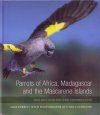Flora / Fauna Identification Key
By: Mike Perrin(Author), Cyril Laubscher(Illustrator)
612 pages, colour photos, colour illustrations, colour distribution maps, colour tables
![Parrots of Africa, Madagascar and the Mascarene Islands Parrots of Africa, Madagascar and the Mascarene Islands]()
Click to have a closer look
About this book
Contents
Customer reviews
Biography
Related titles
About this book
Parrots' colour and charisma, coupled with the fact that they mimic human speech, make them fascinating to many people. They are ancient birds with unique bill and foot structures that enable them to forage on fruits in the canopy of forest trees as well as on seeds in grasslands. Because they depend on fruits and seeds all year round, most species are confined to the tropics or sub-tropics, where the world's biodiversity is at its greatest. There are over three hundred species of parrots, of which more than one hundred are recognised as rare, endangered, vulnerable or threatened with extinction.
Parrots are largely distributed in tropical areas of developing countries where economies are weak and uncertain, and where there is great dependence on the exploitation of natural resources, particularly hard wood evergreen forests, which are preferred parrot habitats. Unfortunately, high levels of corruption are common to these regions, with much illegal trade in animals and little or no law enforcement. Collectors of parrots in the first world pay huge sums for rare parrots. However, research, education and conservation actions are greatly reducing illegal trade in African parrots.
Parrots of Africa, Madagascar and the Mascarene Islands provides complete coverage of all aspects of the biology of extant African, Malagasy and Mascarene parrots, and reviews our knowledge of extinct and fossil parrots from the region. Particular themes include the behavioural and ecological characteristics of parrots, their species characteristics and conservation biology. Current concepts in avian and conservation biology are also discussed.
Parrots of Africa, Madagascar and the Mascarene Islands is aimed at ornithologists, conservation biologists, avian ecologists, academics, bird watchers and parrot fans alike. It is well illustrated, with high quality original photographs, and includes distribution maps, figures and tables.
Contents
Contents
Acknowledgements
List of tables
List of figures
Abbreviations
Chapter 1: Introduction 1
Chapter 2: Conservation biology 27
Chapter 3: Systematics 65
Chapter 4: Biogeography and niche separation 83
Chapter 5: Intelligence, communication and behaviour 103
Chapter 6: Breeding biology 129
Chapter 7: Diet and metabolism 159
Chapter 8: Case study - the Cape Parrot 193
Chapter 9: Trade in African parrots 241
Chapter 10: African parrot conservation 285
The Parrot Species of Africa 308
lUCN Categories 311
Chapter 11: Long-tailed and fossil parrots 313
Chapter 12: True parrots 351
Chapter 13: Lovebirds 455
Chapter 14: Field techniques in parrot research 519
Species lists 526
Glossary 546
Bibliography 552
Index 595
Customer Reviews
Biography
Mike Perrin obtained his BSc Hons at Royal Holloway College, University of London and his PhD at Exeter University. He undertook a Post-doctoral Research Fellowship in Canada and his first lecturing post was at Makerere University in Uganda. Having then lectured for six years at Rhodes University, he took the Chair of Zoology at the then University of Natal, where he is now Professor Emeritus and Director of the Research Centre for African conservation. He has contributed to a dozen books, about 250 scientific publications and supervised many post-graduate students.
Flora / Fauna Identification Key
By: Mike Perrin(Author), Cyril Laubscher(Illustrator)
612 pages, colour photos, colour illustrations, colour distribution maps, colour tables
"This large and heavy tome is a curious compilation. It is in many ways a textbook of avian ecology starring parrots, but at the same time it has the somewhat disjunct feel of a conference proceedings, despite being written by a single author. There is a reasonable logic in the chapter heads, but within each chapter one finds an eclectic mix of autecological data (often paraphrased from specific studies by others) and more general overviews of the chapter ’s topics. [...] Editing has been somewhat lax, in that there is throughout a lot of repetition; while it can be argued that this can help information to stick in the reader’ s brain, it does make the book very long. [...] In short, lots of information, but readers should make careful use of the Bibliography to cross-check."
- Anthony Cheke, Ibis (2014), 156, 478–489
"The book, Parrots of Africa, Madagascar and the Mascarene Islands by Mike Perrin with photos by Cyril Laubscher, is long overdue and is a proud addition to my coffee table. [...] Here then is a book that appeals to all bird fans – from ornithologists to academics and bird-watchers to bird-keepers. There is enough eye-candy in the form of great photos to keep most people page-turning, although I would have preferred more pictures. [...]"
- Simon Espley, Africa Geographic Blog, 23-12-2013









































